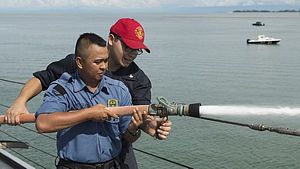Earlier this month, in a notable development, the United States and Brunei held their first-ever army exercise. While the engagement itself was among the more modest U.S. military interactions with Southeast Asian states and just one of the activities that the two countries hold within their broader defense relationship, it is still significant given the trajectory of bilateral ties and the wider regional and global changes at play.
As I have noted before in these pages, the United States and Brunei – a small but nonetheless important player on a range of regional security issues, from terrorism to the South China Sea – already have an ongoing defense relationship, which includes various bilateral components such as ship visits, staff talks, and exchanges, along with other wider multilateral components as well such as the Southeast Asian state’s involvement in the Cooperation Afloat Readiness and Training (CARAT) exercise and the Southeast Asia Cooperation and Training (SEACAT) drills.
In recent years, the United States has looked to expand its exercises and wider defense engagements in the Indo-Pacific, which has also included upping collaboration with some Southeast Asian states. With respect to the U.S. Army, one of the programs that is testament to that is Pacific Pathways, an annual military exercise that the United States has held since 2014, which includes several strategic deployments around the Pacific.
While often missed in the headlines, Pacific Pathways has seen some notable developments take shape over time, including two-way engagements held in the region and in parts of the United States as well as the integration of individual U.S. states. This year, for instance, Pacific Pathway engagements in the summer leg from June to September are being led by a National Guard Unit for the first time since the creation of the program, with coverage across Australia, Malaysia, Indonesia, Thailand, South Korea, Japan, and Brunei (the iteration earlier this year covered Thailand, South Korea, and the Philippines).
This month, we saw an example of cooperation within the U.S.-Brunei relationship and Washington’s ongoing plans to expand its regional defense arrangements with the holding of the first bilateral training exercise between the armies of the United States and Brunei. The exercise, Exercise Pahlawan Warrior, was designated as one of the engagements held under the summer segment of Pacific Pathways involving the participation of some personnel.
The exercise itself was held from August 6 to 16, with 33 U.S. active and National Guard soldiers from U.S. Army Pacific partnering with personnel from the Royal Brunei Land Forces in three locations across the country. The focus areas of the exercise – which included military operations, subject matter exchange, and knowledge sharing – included logical areas for cooperation such as jungle warfare operations and urban terrain tactics.
To be sure, the engagement itself was one of the smaller of the Pacific Pathway activities in the region, and it was also just one of a series of interactions ongoing between the United States and Brunei. Nonetheless, the holding of this first exercise deserves mention within the wider perspective of the bilateral relationship amid regional and global changes.































